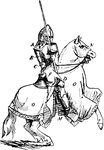
Ten Broeck
"The fastest race horse in the world. His best time, May 24, 1877, was 1.39 for one mile." — S. G.…
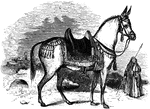
Abyssinian Mule
"The mule is in fact an exceedingly hardy, strong, and useful animals. In all mountain countries, for…
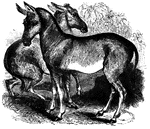
Hemiones
"In this the fur is short, smooth, and bright red bay; the legs are straw color; there is a broad, longitudinal…
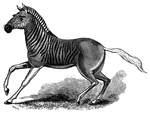
Quagga
"Its general color is brown, the head, neck, and withers striped or zebraed wth blackish-brown; the…
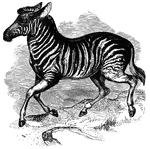
Dauw
"Is of a pale brown color; the underside of the body being whitish; head, body, and upper part of the…
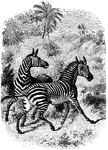
Zebras
"The ground color is white, or yellowish white, but the head, body, and legs to the hoofs are regularly…
Railroad Trail
"Trail between Peter Cooper's locomotive Tom Thumb and one of Stockton's and Stokes' horse…

Moa skeleton
The partial skeleton of a moa, an enormous flightless bird once native to New Zeland, now extinct.

Ridgefield
Place of the barricade, Ridgefield. This view is at the north end of the main street. It was taken from…

Washington Elm
"The Washington Elm. The horse seen in this sketch is one of the oldest in Cambridge, having been built…
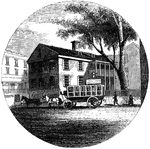
Providence Tavern
"Old Tavern in Providence. This view is from the market, looking north. The building stands on the east…

Perch skeleton
"The bones of fishes are of a less dense and compact nature than in the higher order of animals; in…

Seahorse
"These animals have a head of the shape of a horse, and a long tail without any fin, but which is used…

Scad
"Fifteen to twenty inches long; caught in great numbers on the coast of Ireland, and common on the British…
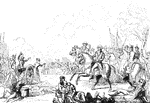
Monmouth
"The field of Monmouth. In the picture here given, the chief is seen most prominently on his white charger,…
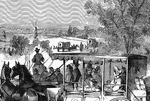
Grand Skedaddle - Horse-drawn Carriage
"The 'Grand Skedaddle' of the inhabitants from Charleston, S. C., when threatened by an attack from…
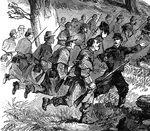
Battle of Mill Spring
"Battle of Mill Spring, on the Cumberland River, near Jamestown, between a confederate force, 8,000…
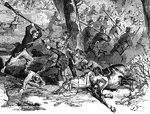
Battle of Mill Spring
"Battle of Mill Spring, on the Cumberland River, near Jamestown, between a confederate force, 8,000…

Battle of Mill Spring
"Battle of Mill Spring, on the Cumberland River, near Jamestown, between a confederate force, 8,000…
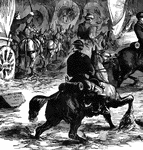
Lick Creek Bottom - Horse and Rider
"Advance of Federal troops on Corinth- the Carnival of Mud- scene at Lick Creek Bottom, between Pittsburg…
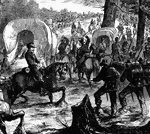
Lick Creek Bottom - In the Mud
"Advance of Federal troops on Corinth- the Carnival of Mud- scene at Lick Creek Bottom, between Pittsburg…

Lick Creek Bottom - Marching through the Mud
"Advance of Federal troops on Corinth- the Carnival of Mud- scene at Lick Creek Bottom, between Pittsburg…
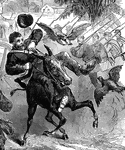
Foraging Spoils - Startled Horse
"Return of a foraging party of the Twenty-fourth Regiment, Connecticut Volunteers, with their spoils,…

Myxine
"The body is long and eel-like, and the skeleton is reduced to a mere cartilaginous tube. It ours out…
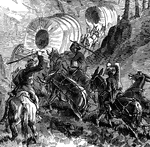
Baggage Train to Falmouth, VA
"Federal baggage train on its way to the army at Falmouth, VA., December, 1862. Our illustration represents…

Baggage Train Wagon
"Federal baggage train on its way to the army at Falmouth, VA., December, 1862. Our illustration represents…
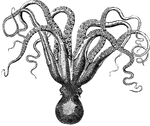
Cuttlefish
"It has no shell, and no skeleton, but has two conical pieces of horny substance imbedded in the back,…

Fort Watson
"Site of Fort Watson."—Lossing, 1851 The Siege of Fort Watson was an American Revolutionary War confrontation…
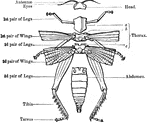
External Anatomy of an Insect Skeleton
"Anatomy of the external skeleton of an insect" — Goodrich, 1859

Cocktails
"The larvae are very similar to the perfect insects, both in appearance and habits. Many of them feed…
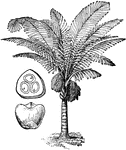
Arenga
"Areng. It yields a black bristly fiber resembling horse hair, which makes excellent cordage, and is…

Steam Fire Engine
"A Fire Engine is a machine employed for throwing a jet of water for the purpose of extinguishing fires.…
!["A Tooth is one of the hard bodies of the mouth, attached to the skeleton, but not forming part of it and developed from the dermis or true skin. True teeth consist of one, two, or more tissues differing in their chemical composition and in their microscopical appearances. Dentine, which forms the body of the tooth, and 'cement,' which forms its outer crust, are always present, the third tissue, the 'enamel,' when present, being situated between the dentine and cement. The incisors, or cutting teeth, are situated in front. In men there are two of these incisors in each side of each jaw. The permanent incisors, molars, and premolars are preceded by a set of deciduous or milk teeth, which are lost before maturity, and replaced by the permanent ones. The canines come next to the incisors. In man there is one canine tooth in each half-jaw. The premolars (known also as bicuspids and false molars) come next in order to the canines. In man there are two premolars in each half-jaw. The true molars (or multicuspids) are placed most posteriorly. In man there are three molars in each half-jaw, the posterior one being termed the wisdom tooth. The figures [in the illustration] refer to months after birth."—(Charles Leonard-Stuart, 1911)](https://etc.usf.edu/clipart/15200/15256/teeth1_15256_mth.gif)
First Teeth
"A Tooth is one of the hard bodies of the mouth, attached to the skeleton, but not forming part of it…
!["A Tooth is one of the hard bodies of the mouth, attached to the skeleton, but not forming part of it and developed from the dermis or true skin. True teeth consist of one, two, or more tissues differing in their chemical composition and in their microscopical appearances. Dentine, which forms the body of the tooth, and 'cement,' which forms its outer crust, are always present, the third tissue, the 'enamel,' when present, being situated between the dentine and cement. The incisors, or cutting teeth, are situated in front. In men there are two of these incisors in each side of each jaw. The permanent incisors, molars, and premolars are preceded by a set of deciduous or milk teeth, which are lost before maturity, and replaced by the permanent ones. The canines come next to the incisors. In man there is one canine tooth in each half-jaw. The premolars (known also as bicuspids and false molars) come next in order to the canines. In man there are two premolars in each half-jaw. The true molars (or multicuspids) are placed most posteriorly. In man there are three molars in each half-jaw, the posterior one being termed the wisdom tooth. The figures [in the illustration] refer to years after birth."—(Charles Leonard-Stuart, 1911)](https://etc.usf.edu/clipart/15200/15257/teeth2_15257_mth.gif)
Second Teeth
"A Tooth is one of the hard bodies of the mouth, attached to the skeleton, but not forming part of it…
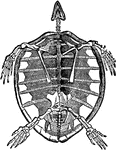
Skeleton of Turtle
"Turtle is, in zoology, the popular name for any species of the Cheloniidæ. They may be distinguished…
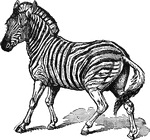
Burchell's Zebra
"Zebra is a popular name for any of the striped forms of the genus Equus; thus embracing the quagga,…

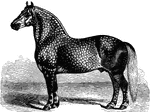
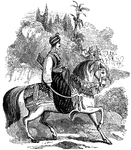



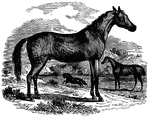
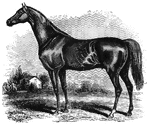
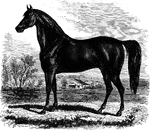
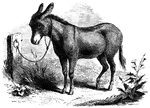
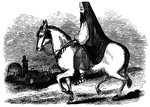
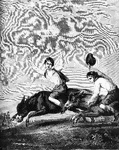





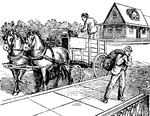

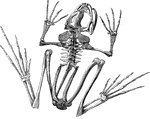

!["[Late 19th Century/Early 20th Century] United States Army Ambulance"-Whitney, 1902](https://etc.usf.edu/clipart/14600/14641/armyambul_14641_mth.gif)
